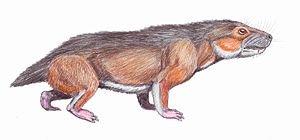Baurioidea
| Baurioidea | ||||||||||||
|---|---|---|---|---|---|---|---|---|---|---|---|---|

Bauria |
||||||||||||
| Temporal occurrence | ||||||||||||
| Upper Perm to Lower Triassic | ||||||||||||
| 268.8 to 247.2 million years | ||||||||||||
| Locations | ||||||||||||
|
||||||||||||
| Systematics | ||||||||||||
|
||||||||||||
| Scientific name | ||||||||||||
| Baurioidea | ||||||||||||
| Broom , 1911 |
The baurioidea or Bauriamorpha are an extinct group of terrestrial vertebrates from the group of Therapsid ( "mammal similar reptiles") extending from the Permian to the Lower Triassic lived.
features
Baurioids were rather small to medium-sized, their snouts were short. Their molars, provided with widened tooth crowns, converge to those of later herbivorous cynodonts and show that they ate fiber-rich vegetable food. The post- orbital bone brace that separated the orbit from the short cranial windows has disappeared. The parietal bones were flat and narrow, the hole for the parietal eye is missing in many forms, the post-frontal (hind frontal bone ) in all of them. They had an almost fully developed secondary palate that was formed without involving the palatine . It allows breathing while at the same time ingesting food and, in addition to the possible separation of the chest and abdominal cavity by a diaphragm, is a sign of a higher metabolic rate and endothermia . The phalangeal formula is 2.3.3.3.3.
Systematics
Kuhn gives 9 families and 45 genera for the Bauriamorphs. In the past, many paleontologists believed they were close to the origins of some groups of mammals. Today, on the other hand, the cynodontia are the sole parent group of mammals.
literature
- Thomas S. Kemp: The Origin & Evolution of Mammals. Oxford University Press, Oxford 2005. ISBN 0198507615 .
- Michael J. Benton : Paleontology of the vertebrates. 2007, ISBN 3899370724
- Robert L. Carroll : Paleontology and Evolution of the Vertebrates , Thieme, Stuttgart (1993), ISBN 3-13774-401-6
- Oskar Kuhn: The mammal-like reptiles . A. Ziemsen Verlag, 2003, ISBN 3-89432-797-9